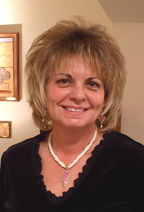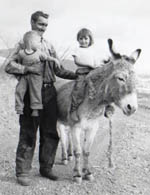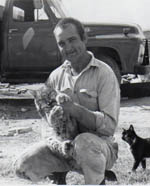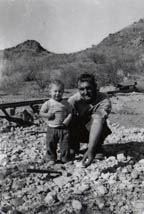"Into
Arizona"
From the age of four, in my little girl
cowboy boots, I followed my "rockhound" father up and down
the hills and canyons of southern Arizona between Tucson
and the Mexican border. Tripping over rocks, dodging cacti
and whining for Daddy to carry me sometimes, and he always
did, we trudged along looking for mineral specimens in
secret locations. I followed along as he would always say,
“were just going up here a little ways”, and on we went
throughout the day, often resting in the shade of a
mesquite tree when it was hot. We saw lots of rattle
snakes, gila monsters, coyotes, coatimondi, bobcats and
even wild burros. As we traipsed along I enjoyed the
scents, light, colors, sounds and textures of the desert
that I have grown to love so much.
We spent hours winding down dusty back roads in the old
pick up truck, opening and closing ranchers gates and
prying our way through barbed wire fences. My dad hated
gates and fences. He thought no one had the right to keep
anyone from going where they wanted to go. He always went
where he wanted to go even if there were signs posted “Keep
Out”. No one ever caught us, we were in the wild open
spaces of "the great southwest", having a wonderful time.
We even made a family pet out of one of those wild burros
who was actually very friendly allowing us to put a rope
around it’s neck to be lead around with my little brother
Johnny and me on it’s back. Later we also raised an
abandoned baby bobcat until it was two years old. It was
great fun.
For a little over two years, from 1956 to 1958, I lived
with my family at the “Glove Mine”, in southeastern Arizona. The
mine is located at the southwestern end of the Santa
Rita Mountains, near Amado, in the Tyndall Mining
District of Cottonwood Canyon. The mine derived its name
from its general shape of a glove. The mine's deep
underground cavity was at one time filled with
incredible wulfenite crystals. This
formation, known as a vug, (a cavity in rock lined with
mineral crystals), is the result of deep magma chambers
pushing up towards the surface of the permian limestone
layer which created tubes or chimneys. This area was at
one time under a sea, as well as being in an
intersection fault plane, and over time the pockets
filled and drained with water and minerals, again and
again, forming the crystal lined cavities. My father,
F.G. Mack and his brother Edward Mack, who was part
owner at the time, were working in the mine to extract
the precious wulfenite crystals that lined the glove
shaped cavity. We lived in a small cement block house
just up the hill from the entrance to the mine tunnel.
The mine was carved into the hillside and at the back
end a deep shaft went straight down into the ground. I
can still remember the smell of the carbide lamps that
they wore on their hats and the feeling of the cool air
from the dark, dank shaft. I could go inside the tunnel
but I was not allowed to go down into the shaft to the
deep hole.
They brought up many beautiful wulfenite specimens. At home
I remember stacks of boxes filled with the valuable
crystals, carefully wrapped in cotton, waiting to be sold
or traded at the Tucson Gem and Mineral Show. This trading
went on for several years. The finest crystals that they
found were sold to Albert and Bernie Haag, well known
mineral collectors from Tucson and parents of Robert Haag, meteorite collector, Zee Haag, mineral collector and Terri Haag, author and archeologist.
Albert and Bernie then sold the wulfenite specimens to
The Smithsonian National Museum of Natural
History, Department of Mineral Sciences
Collections, www.mineralsciences.si.edu. You can see
the database of that wulfenite collection when you type
in, Glove Mine wulfenite, on
their Mineral Sciences Collection Search
page.
When it was time for me to go to school, we moved from the
mine into the nearby small community of Amado. I had to
ride a bus to a small two room school house down a long
country road. That year a small single engine airplane
crashed into our house, nearly killing my mother and me. At
age six I was just a bit too young to appreciate such a
near death experience. We then moved to Tucson where my
father took a job with the railroad. During the weekends he
would still love to venture out searching for treasure from
some treasure story he had read in Arizona Highways or
mineral specimens that he thought might be in a certain
location. I was with him when he unearthed an incredible
aquamarine crystal after blasting a hole in the ground near
the Twin Buttes Mine just south of Tucson when I was
twelve. He had a piece of it faceted and set in gold for my
mother. It was beautiful. While he worked in the ground, I
was off exploring the desert by myself. I loved to play in
the washes. I would dig in the cool sand feeling the
crushed granite and quartz in my hands and watching the
tiny crystals glitter in the sun. My addiction to sparkling
rocks was well under way.
Later these experiences inspired me to want to learn the
jewelry arts. I was already in love with rocks and wanted
to do my own thing with them. By the age of twenty one,
while attending The University Of Arizona in the fine arts
program, I took a little trip down to Bisbee Arizona, ninety miles southeast of
Tucson, during winter break. It was at that time that I
found myself in a place that was very interesting and
very creative. In 1972, Bisbee was, and still is, a
charming little community filled with artists and I
wanted to move there more than anything else, so I did.
I was already a painter and I wanted to learn to work
with copper and silver and how to cut stones. I
purchased a set of silversmithing tools
and a lapidary unit and began to
teach myself. I still use the same tools today, however
I am now on my third lapidary unit. There was allot of
Bisbee turquoise available at that time because the
Copper Queen Mine was still in operation.
You could buy it from the "night time dump raiders",
guys that would brave the mine tailings in the middle of
the night with a flashlight and a blanket for cover, all
very illegal of course. The next day they would go
around to all the silversmiths to see if they wanted to
by any of the lovely blue stones. “Bisbee Blue” was
everywhere and cheep. When I think of the beautiful
stones that I cut and set in my early settings, I just
cringe! Just try to find that stuff now. I purchased my
first house in Bisbee way up on the hill behind the
Copper Queen Hotel. Real estate was very
inexpensive there back then. I also bought a second
house across from the court house in Tombstone Canyon.
It had seventy four steps up to the front door from the
street and walking up the steps was the only way to get
to the house. At that time I was often up and down those
steps several times a day. My first child learned to
walk and navigate those steps in that home. Each morning
one of the wild burros that roamed the hills above town
would come down near my back yard and "heehaw" over and
over again. I loved it. Bisbee was and still is a trippy
little town. It was there that I began my adventure in
the lapidary and jewelry arts, first selling in crafts
fairs, then opening a small gallery shop in Brewery
Gulch with two other artists in the mid 1970's. I left
Bisbee in 1978 for Washington State but there is still a
soft spot in my heart for that lovely little town.
While living in Washington for six years, I sold my work in
several places. I moved back to Tucson in 1984 and began
regularly searching the gem shows for rocks, crystals and
mineral specimens to cut. I found a gallery right away and
started selling my jewelry again. After years of cutting
all kinds of material and learning difficult inlay work, I
have found that my favorite stones to work with are
beautiful natural drusy crystals.
They require much less cutting. They are like tiny
sparkling sugar crystals that form on the surface of a
rock as a crust or in veins or cavities. Drusy
formations come in a variety of colors with a vast array
of mineral content and from many locations worldwide.
Cutting them can be challenging because they are very
lovely and you want to save as much of the specimen as
you can. Some drusy agates are extremely hard and very
difficult to cut, while other specimens are delicate
with fracture plains and other crystal inclusions. I
will purchase a chunk of rock with a drusy crust or
cavity then proceed to cut the drusy surface away from
the mother rock with my slab-trim saw. The first cut is
always the hardest. Sometimes you’re not quite sure
where to begin. Often the rock has to be studied. I
leave enough of the mother rock under the crystal
formation so that it has a stable base for setting. Then
I just trim the edges in freeform shapes. I also love
cutting and setting many other chunky crystals such as
amethyst, citrine and a host of others. After cutting my
stones, I store them in glass stone cases by individual
categories.
I love searching the rock shops and gem shows for treasures
that spark my imagination. I look for colors and textures
that are pleasing to my eye, gathering rough rock, crystal
specimens, faceted and cabochon cut stones, stone beads and
pearls. I also enjoy learning as much as I can about all of
the stones that I use in my work, as you can read on my
Geological page. I love the
combination of a drusy crystal set with a faceted
stone and a cabochon cut
stone in complementary shapes of monochromatic or
complementary colors. It‘s an interesting grouping of
color, cut and texture. I also like setting faceted
stones in bezel settings because it better protects the
stone, allowing it to stay clean and full of sparkle. It
also creates a more sumptuous setting. I love pairing
drusy with gold and gold on silver, it just seems so
fitting, so pretty and colorful. I love simple lines and
hammered texture. The challenge is working with all of
the components to put together an interesting and
wearable design. See all of my work in the Jewelry Gallery pages. I
spend hours doing sketches for many pieces at
a time before I actually start the work. I most often
work on eighteen to twenty pieces at a time. I like
making a sires or exhausting an idea and then laying it
to rest and moving on to the next. Choosing stones,
cutting stones, sketching designs and doing metal
fabrication are all of the things that I love to do with
what has been a life long interest and passion.
Sometimes life is strange, you don’t know why you’re living
at a mine when you’re four and five years old, or traipsing
all over the hot desert in your cowboy boots, watching out
for snakes, or why you walk with your head always looking
on the ground for something unusual. Eventually it all
makes sense and you realize that you are right where you’re
supposed to be, right where you were led to be and right
where you want to be, doing what you know and love.
Marilyn Mack




Our pet burro, bobcat and Dad with my little brother Johnny
at the Glove Mine in the late 1950's.
Top
Return to Artist's
Statement
Return to Wulfenite
Crystals